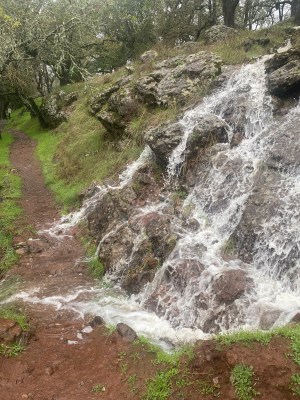The Trail Maintenance Team for the Sonoma Overlook Trail does a variety of tasks, but one of the most important things we do is manage the flow of water across the trails. Essentially, what we try to do is to move the water off the trail as soon as it comes on. The best way that this happens is in sheet flow from the upper side of the trail to the lower side, but that is rarely the situation we can accomplish.
One challenge is that water often comes onto the trail not in a gentle sheeting flow, but in what is essentially a tiny creek. Another is that it isn’t always an option to have the water sheet off the downhill side. We often need to allow it to flow down part of the trail before directing it off in a waterbar (a channel we cut in the trail to force the water off the trail).
There are also other structures we build to manage water. Perhaps chief among them is the armored swale. An armored swale is essentially a deep channel you cut in the trail that you “armor” with rocks so it doesn’t erode as the water flows over it and off the trail. Another strategy we use to encourage sheet flow off the trail is cut the “berm” or the very edge of the trail that can build up in a way that keeps water on the trail instead of allowing it to sheet flow off of it.
All of these structures require ongoing maintenance, and the more subtle structures require more maintenance than the more dramatic ones.
Over the last few days (one of them during the recent rainstorm) I was out renewing the structures in place and cutting berm to better enable water flow off the trail. I also deepened a few waterbars and performed other tasks to better channel water from the trail. I will again be out there tomorrow afternoon during the rainstorm with a shovel, to see what needs fixing. It’s part of what we stewards do.




